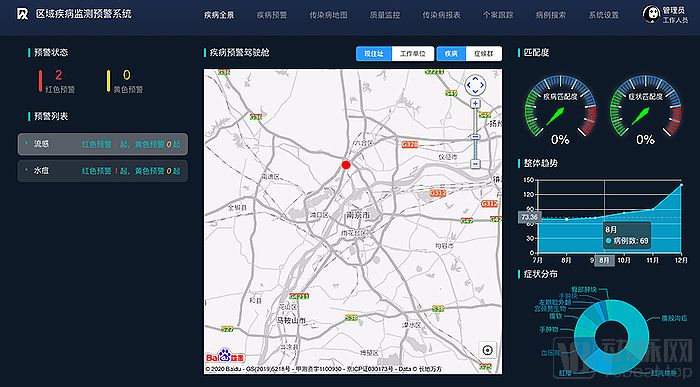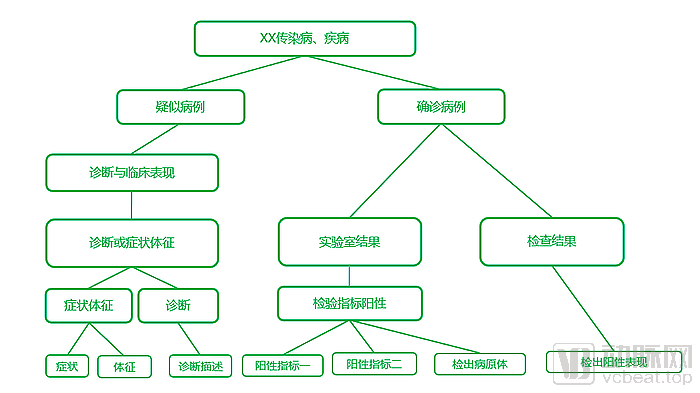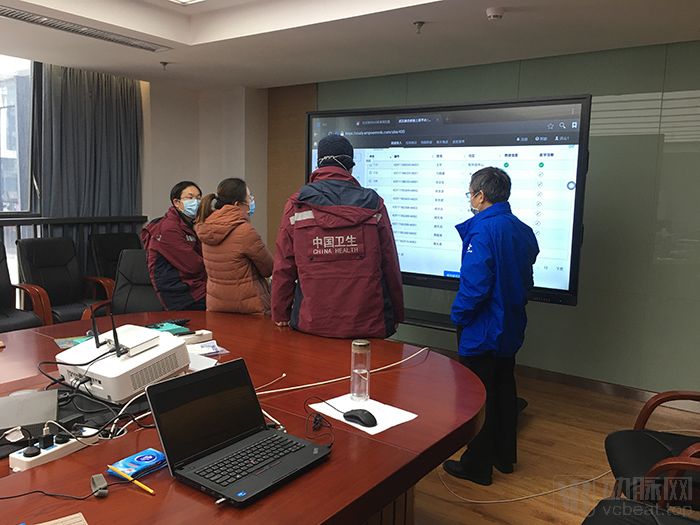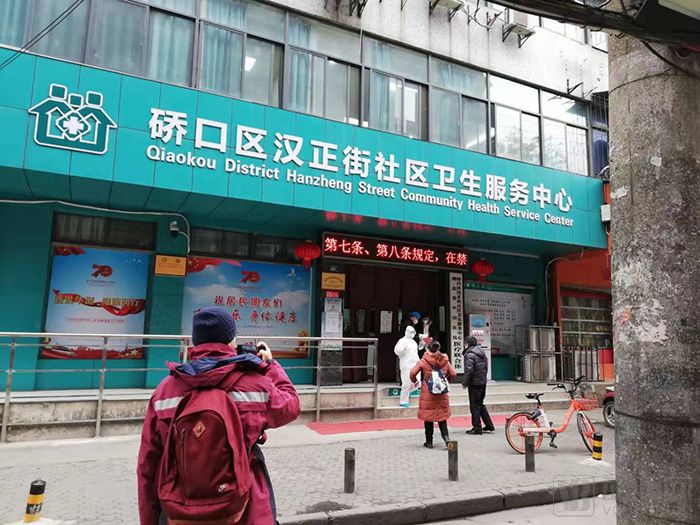What contribution has big data made to the epidemic prevention and control?
Editor’s note: This article is from WeChat public account “Arterial Network” (ID: vcbeat) author: Chen Peng.
Unlike the past, China ’s science and technology level has now greatly improved, and it even leads the world in certain fields, especially innovative technologies such as cloud services, big data and artificial intelligence technologies. In this epidemic prevention and control work, we armed ourselves with high technology to turn these technologies into powerful weapons against the epidemic, and have been widely applied in the areas of epidemic tracking and traceability, path propagation, development model prediction, and resource allocation.

Application of big data in disease control in this article (arterial network mapping, for reference only)
What contribution has big data made to the epidemic prevention and control? What potential role can it play in future disease control? The arterial network combed this.
Big data is indispensable in disease control early warning and monitoring. The premise is “real” data
According to media reports, on December 26, 2019, Zhang Jixian, director of the department of respiratory medicine of Hubei Provincial Hospital of Integrated Traditional Chinese and Western Medicine, was surprised to find that in the electronic medical record system, three other similar data had fever in the morning , Cough, and the South China seafood market are all three of the same keywords.
Experienced Zhang Jixian felt abnormal and reported to the dean, the hospital and the medical service on December 27. The hospital decisively reported the data to the Center for Disease Control and Prevention of Jianghan District, Wuhan City. By December 29, similar data had increased to seven, and Zhang Jixian reported to the hospital again. The hospital immediately held a multi-department consultation, and then the Hubei Provincial Hospital of Integrated Traditional Chinese and Western Medicine reported directly to the Hubei Province and the Wuhan Municipal Health and Disease Control Center.
Zhang Jixian is considered to be the “first person to report the epidemic situation”, and Hubei Provincial Hospital of Integrated Traditional Chinese and Western Medicine is the first hospital to officially report the epidemic situation.
The earliest case in the public report dates back to December 8, 2019. During this half month, other hospitals in Wuhan have also received similar cases. According to reports, due to careful consideration, the hospital chose to first perform genetic sequencing to determine the pathogen before reporting. Considering this is a brand new virus, the geneSequences also take time, and that’s understandable.
However, let ’s assume that if there were big data and artificial intelligence that could catch these early clues at the first time, would the situation develop in another direction?
Of course, some people will also question why the system started operating in 2004, when the National Infectious Diseases and Public Health Emergency Network Direct Reporting System (hereinafter referred to as the CDD Special Reporting Network) cost 730 million yuan to build. Did not play an early warning role?
According to the understanding of the arterial network and the public reports from the media, the CDC private network is not ineffective, but its data source depends entirely on the reported data. Due to various factors, the CDC private network cannot connect with the hospital’s internal network Connect directly. No data can be collected, so this system cannot work.
On February 3, the Health and Medical Commission issued the “Notice on Strengthening Informatization to Support Pneumonia Epidemic Situation of New Coronavirus Infection”. The health and health commissions in various places have continuously improved the collection method according to the notice. Most hospitals have begun to adopt the method of direct network reporting, and finally they have gradually played the role of a dedicated network.
The real source of data is an extremely important step for big data. During the development of this epidemic, we can clearly find that the conclusions drawn from the wrong data are far from the facts. How to get real and reliable data from the front line of medical institutions? The main systems of electronic medical record system (EMR), laboratory information management system (LIS), medical image archiving and communication system (PACS), and hospital information system (HIS) provide us with reliable data sources.
EMR is the first link of the data source, and it is also a core system in the promotion of hospital informationization promoted by the state. From 2018 to 2019, a total of 9 policies from the State Council and the National Health and Medical Commission mentioned in detail the hard requirements for electronic medical records. In 2019, a total of more than 7,000 hospitals across the country submitted national electronic medical record ratings.
Using big data and artificial intelligence to analyze EMR and apply it to disease control is not impossible. This is a hot topic at present. The disease and surveillance and early warning system that Beijing Dashu Yida built for the Nanjing Centers for Disease Control and Prevention directly opened up the EMR connected to the local hospital.
This disease control monitoring and early warning system uses the most advanced big data and artificial intelligence technology of Dashuida, builds a model of medical knowledge map, and then directly extracts EMR for semantic structure, and judges EMR by artificial intelligence matching knowledge base Does it include keywords for infectious diseases such as new coronary pneumonia? Once it is judged to be suspected or highly suspected by artificial intelligence, it should be reported to the disease control department to avoid missing or late reporting by the hospital for some reason.
The system directly connects and connects to the hospital’s EMR, serving as a reporting analysis, data aggregation, and early warning analysis system for provincial and municipal disease control centers. It has a very fine granularity, and in addition to the 40 legal infectious diseases, it also supports regions to supplement their locally identified multiple infectious diseases.

Taidu Elta Regional Disease Surveillance and Warning System (All displays are for display only and do not represent any practical significance)
At the same time, the system combines historical disease control data for learning, and combined with big data such as regional density and population mobility, it can predict the development speed and distribution area of infectious diseases with suspected data, so as to give decision-making for disease control. Reference data.
In general, to effectively implement the epidemic prevention and control work, we need to use AI + big data technology. We need to get through the top-down vertical field data of the “Ministry-Province-City-District-County” in the industry. It is necessary to open up horizontally the “information island” across industries. From the top-level design, real-time structured information interconnection and interoperability and business collaboration and defense are required.
This system, which was built by Jiangsu University of Medical Sciences for Jiangsu Province, was originally prepared for the peak of influenza in spring. It was not intended to play a role in this more severe new crown epidemic. According to statistics, if the epicenter of the outbreak is Wuhan, and a circle with a radius of about 2 hours is drawn along the high-speed rail line, it can be clearly seen that the level of disease control in different regions is not the same. Relatively speaking, the new crown epidemic situation in Jiangsu Province is much better than the surrounding area.
Changsha Double Number Technology, which specializes in intelligent monitoring of infectious diseases, tries to solve the pain points of the entire infectious disease monitoring by solving the pain points of doctors in the current infectious disease report card. The doctor-in-charge system for first-time physicians requires that the first-patient physicians fill out the infectious disease report card for any patients who are found to be infected and who are suspected to be the source of the disease.
Infectious disease monitoring has high requirements for the data quality of infectious disease report cards, including the timeliness of infectious disease reports, and the completeness and accuracy of infectious disease report data. This is a good thing, but it also objectively makes doctors encounter many problems in the process of reporting the actual infectious diseases.
First is timeliness. The current regulations are that Class A infectious diseases must be reported within 2 hours, and Class B and C infections must be reported within 24 hours. However, it takes a long time for doctors to fill out the information on infectious disease report cards. When encountering patients for a long time, it is easy for omissions to be reported in a timely manner, which will lead to late reporting and underreporting of infectious diseases.
Second is the completeness and accuracy of infectious disease report data. At present, most hospitals do not have complete information such as addresses and telephone numbers in the registration system, and they cannot meet the requirements for patient information integrity of infectious disease report cards when filling out reports. The doctor can only ask and enter on the spot, the process takes 3-5 minutes or even longerIt is quite a headache.
Whether the doctor is sufficiently aware of the epidemic situation will also affect the surveillance of infectious diseases. There is an option of “unknown cause of pneumonia” in the infectious disease report card of the CDC Dedicated Network, which can actually correspond to early-onset new coronary pneumonia. The reality is that doctors basically did not choose this selection report, because reporting means that they need to complete a series of registration and filling out and investigation, which is an additional burden for them. Or, even if this option is known, the lack of a clear diagnosis dares not be reported easily or cannot be reported through the rules of existing systems.
The current infectious disease monitoring report card system in hospitals is not smart enough, the intervention plan for doctors is not effective enough, and the infectious disease epidemic management department of hospitals is slow and time-consuming to report infectious diseases. Objective factors to prevent late missed reports are also pain points in the monitoring of infectious diseases. Changsha Double Number Technology has been skilled in practice and believes that these pain points can be solved with big data.

Operational logic of intelligent monitoring program for infectious diseases with double-digit technology
In the intelligent monitoring solution for infectious diseases of double number technology, firstly collect the diagnosis and treatment data of the four major systems of EMR, LIS, EMR and PACS, and then use the double number infectious disease expert knowledge base and semantic analysis technology to conduct the diagnosis and treatment data. Feature extraction and labeling of infectious diseases. Thereafter, the infectious disease analysis model is used to analyze and compare the characteristics, so as to recognize the infectious disease.
Once an infectious disease case is recognized, the system pushes it to the front end of the specific doctor’s computer immediately or delayed, and the forced lock system requires the doctor to complete an important infectious disease report.
From a practical point of view, doctors do have some nuances when they are unfamiliar with the operation in the early stage; but in the process of doctors filling in the card, even numbers use big data + artificial intelligence technology to achieve high-precision recognition and treatment of infectious diseases. A series of optimization schemes such as automatic notification of card information, automatic filling of patient information, intelligent parsing of address information to the street, and automatic deduplication of repeated card reporting, etc., achieve significant efficiency improvements. In the end, the doctors accepted and approved this.
This intelligent surveillance solution for infectious diseases has also achieved the threshold move forward, moving the verification logic of the direct online report for disease control directly to the stage where doctors fill in infectious disease reports. However, the verification cannot complete the report, which effectively solves the problem of card integrity and accuracy.
After the doctor has completed reporting the infectious disease report card, the data is complete and accurateEverything in use “src =” https://img.36krcdn.com/20200314/v2_e077f3baaa1a446d97bab1677dbee667_img_000 “data-img-size-val =” 390,700 “>
In the filling process, the platform supports single account registration information for family members, and can choose the home registration of the jurisdiction to facilitate follow-up visits by community members. At the same time, after the people understand the clues surrounding the epidemic situation, they can contact offline community health centers and community streets to report possible hidden dangers or illegal behaviors (such as the movement of suspicious people, crowd gathering activities, and making fake sales). Promptly investigate the hidden dangers of the epidemic situation, curb illegal behaviors such as raising prices, etc., to facilitate community collective management.
In order to prevent concealment of reports and omissions by grass-roots staff, the health platform needs to obtain the geographic information of the mobile phone when filling in the report, and the grass-roots staff will take pictures and keep them. At the same time, the platform adopts big data thinking at the information collection end, and uses the provincial unified form to fill in the information strictly to improve the standardization of the data in order to support the regional big data platform.
The platform is currently accessing local Internet hospitals for hot consultation online consultation services to reduce cross-infection during offline consultations.
When the doctors and community workers conduct follow-up offline, you can use the platform to complete the tracking object information collection and temperature registration at one time, and provide online physical data tracking at the same time, thereby freeing the grass-roots personnel from filling in the form, which is effective Relieve the working pressure of grassroots staff and improve the efficiency of epidemic prevention and control.
At the same time, the platform also provides a background management function, which is convenient for managers at all levels of government and enterprises to implement personnel registration information and data query statistics in the background based on their respective permissions.

Intellectual Health Burning Cloud Health Management Platform (All displays are for demonstration only and do not represent any practical significance)
At present, the health management platform of Siming District has enrolled a total of 220,000 people, including 60,000 employees belonging to 4,500 enterprises. By using this platform, 6,000 of them are included in key management, which effectively reduces the work pressure of grassroots personnel. Improved prevention and control efficiency, thereby reducing local prevention and control risks.
Next, the platform can also provide students with separate health management for the education system to cope with the peak of resumption. At the same time, the platform is also updating featuresIn order to achieve subsequent iterations such as automatic filling of scanned ID cards and face recognition.
A similar close management platform exists in Wuhan, the epidemic center. Due to the epidemic center, the local disease control work has been under tremendous pressure, and scientific and technological means are urgently needed to improve work efficiency. As in most other places, the investigation of close contact groups (hereinafter referred to as close contact groups) with confirmed patients in Wuhan was initially conducted through an original paper questionnaire and then entered into a computer.
This model is not only inefficient, error-prone, but also has a long data turnaround period. In Wuhan, every second of waste could mean a potential agglomeration. In order to solve this difficult problem, Yi Yi’s scientific research team with expertise in the field of flow regulation customized the EDC flow regulation system for the Wuhan Center for Disease Control and Control and went online within a week.

The system can manage the local close contact population in Wuhan. After obtaining the close contact list provided by the big data platform, the system will import the list into the close contact management system, store the information by district, and allocate related information according to the community grid. At the grassroots level, the mobile personnel in the close contact group can use the system to make inquiries directly during the on-site investigation.
After the data is filled in, it can be uploaded to the CDC in time, and a graphical interface and reports are generated. The CDC staff can see the updated data in time, and can analyze the data more intuitively and conveniently. This system has greatly improved the efficiency of the local CDC’s transmission of confidential information, and greatly reduced the reporting work of grassroots community workers.
The actual process of close reporting is community gridmen-street health service center- district disease control- city disease control- provincial disease control. Reports and functions required by personnel at different levels are different. In order to meet this demand, the Yi Yi team quickly developed customized reports and data export functions on the basis of the previous system, and accurately performed reports according to data permissions at all levels, maximizing the reporting efficiency of units at all levels.
Based on big data thinking, the close contact system includes three layers of data filtering functions. The first is the front-end entry standardization, filtering unreasonable data from the beginning. Secondly, the Yiyi team applied the existing Yiyi data management artificial intelligence to automatically remind errata of suspicious data through dynamic learning of the existing data range; finally, it can cooperate with manual review to sample and approve the data. In order to ensure the quality of the extracted data, it has helped the application of data on the big data platform.

As of now, the EDA EDC close management platform covers all administrative areas and centralized isolation points in Wuhan. It is used by more than 700 CDC and community service personnel, and has accumulated more than 80,000 close contact data. At the same time, the local disease control department is also applying to connect with the resident identity system, complete the connection of all data at one time from the entry source, connect all the data such as close contact, flow adjustment, residence information and social relations, and bring the data value to a greater extent.
Big data construction, do not change the original intention of opening the “information island” into more “information islands”
One fact is that in the informatization of health informatization in recent years, the progress of public health informatization has lagged significantly. The CDC dedicated network mainly stays in the reporting of various infectious disease information, and the use rights are basically at the national level, and the provinces, cities, and counties cannot use the data and cannot form timely and effective analysis conclusions.
At the same time, the work of the disease control centers at all levels, including disease surveillance, vaccination, and health emergency management, has failed to establish an information system connected to Shanghai.
Although various regions are investing in the establishment of big data platforms, the national universal health basic information system and the disease control agency information system promoted by different regions are far from the same, regardless of the basic information collection, entry, standard use and management departments. It has not built a unified and efficient public health information platform. Much data cannot be used effectively.
Frankly, every department and region is fighting. Without the top-level overall design and promotion, the original intention of eliminating “information islands” might have created more “information islands” in the future.
For this potential problem, industry experts believe that it is necessary to carry out unified planning and standardization of big data construction so that different platforms can be effectively connected, and do not create more “information islands”. At the same time, we should pay particular attention to the effective operation of data, and the application must be implemented in specific business scenarios. Otherwise, the big data collected through painstaking efforts will be too large and useless, which will offset its due effect.
Write at the end
We have to soberly realize that, despite many remarkable points in this battle, the Internet + and big data applications are in full swing, but it also reveals that the informationization level of China’s disease control system needs to be improved.
A number of experts from the Chinese Preventive Medicine Association’s New Coronavirus Pneumonia Prevention and Control Expert Group jointly pointed out in the article “Thinking and Suggestions on the Modernization of the Disease Prevention and Control System” that public health big data and information systems are the modernization of the disease control system An important part ofImportant means and support for improving public health service capacity.
In the future, we should build on the national informatization of national health basics, rely on the reform and improvement of the public health service system, deeply integrate medical services and public health basic information, and use blockchain, big data, artificial intelligence, cloud computing, Technologies such as the Internet of Things are closely centered on the “accurate full-dimensional real-time big data collection system”, “disease monitoring and epidemiological artificial intelligence deep learning system”, “big data cloud computing intelligent early warning prediction system” and “emergency emergency unified resource management and deployment” The system ”plays an important supporting role in normalized monitoring, early warning and treatment of epidemic conditions, research and judgment of trend prediction, traceability of source of infection, resource allocation and prevention and treatment.
Relying on the national health information platform, based on electronic medical records, health files, and the entire population database, under the support of information security, standards, and operation and maintenance support systems, improve and improve the nationwide epidemic report monitoring and early warning and its Public health emergency information network system. Establish a public health cloud platform and disease control business application system, and implement a series of platform-based platforms such as dynamic disease surveillance and early warning and treatment, full-process management of child vaccination, monitoring and evaluation of health hazard factors, occupational health, maternal and child health, and comprehensive supervision services. Business Applications.
The public health cloud platform is used to establish public health information services for the public, so that ordinary people can truly appreciate the convenience brought by informatization, so as to improve the timeliness, convenience and fairness of public health services and improve the satisfaction of the public. .




